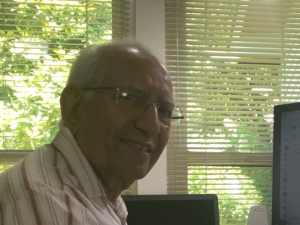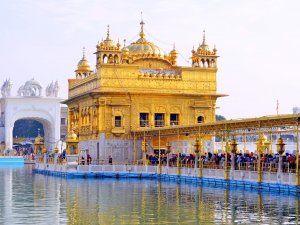In the past few days, I read Sardar Rup Singh’s write_up on my dear colleague, Sardar Manjit Singh Calcutta, who passed away recently. Sardar Rup Singh was a past colleague of the All India Sikh Students Federation (AISSF). He tallied the numerous contributions of Calcutta Sahib in Panthic history, but he had to leave out many specifics as the memory of those events were never deposited in the Sikh archives.
I have seen many of my friends and colleagues pass away on their way to the timeless journey of their souls, as we Sikhs term death.
The Haunting Concern
Often, a question haunts us, the survivors: why didn’t the departed one leave behind for posterity their account of the significant events which they had witnessed and often participated in?
Such past events inevitably shape us into what we are today. Our history shaped who we are today, and what our future will be. Thus, it is to our collective benefit to know of the events from the past, for they significantly define our actions today.
To our misfortune, we in my community have not cultivated the tradition of creating annals of history, preserving archives or establishing other depositories. The lessons of our past several decades are not accessible for transmission to the succeeding generations. In their absence, we are becoming vulnerable to frequent mistakes and constant manipulations from outsiders.
In the absence of the written accounts, only heresy and false stories determine our national behavior and, sometimes, wrongfully define our belief systems. They often become a reaction to the deliberate and massive mayhem that are created by politicians and clergy alike, our own and others’. They may be aided by ignorant, shortsighted or misguided zealots, or more recently even by extremists or terrorists with vested interests that are dictated by our detractors.
The Heresy and History
Many of the heresy and unconfirmed stories often get away with murder just by maintaining a facade of piety; those faces in the heresy alone are becoming a virtual defense against complexity and wisdom. Only sincerely described record keeping can stop it.
Sikh history has been a turbulent one since its beginning and the last decades have been no exception. We have experienced many distortions through British colonialism, the Partition of Sikh homelands on arbitrary accounts and along arbitrary borders, the loss of sacred shrines and properties, and 1984 ghalughara.
The Challenges
Newer episodes after the evacuation from Pakistan and the pogroms of 1984 have challenged us to grapple with new realities and to adapt to the inevitable secularization of our political representation.
In the past decades that I have witnessed and those witnessed by my colleagues as well as their elders included many developments that were accompanied by stresses and growing pains that are irreversibly changing the face of our nation. They included the rise of the Singh Sabha movement, management of Sikh resources and religious doctrines by institutions built upon an ever-shifting adult franchise, and growth of science and technology. There has been the rise and fall of public movements such as the All India Sikh Students’ Federation, the Sikh institutions of higher learning, and the ever-expanding Sikh diaspora.
My contemporaries in their youth experienced the spirit when all Sikhs – sehaj-dhari, khande-de-pahul-dhari, and even those at the fringes of Sikh society, or, those not also claiming to be Sikhs, were on the same team. They often shared similar values all inherited from their ancestors. It is those times in history that the Sikh intellectual of the time, Professor Puran Singh used to say,”Panjab na Hindu na Musalmaan, Panjab jeenda Gura(n) dey naam te. It meant: “Punjab is neither Hindu nor Muslim; Punjab lives in the name of the Gurus. Thus, the Punjab of Puran Singh’s time, if persisted, would be populated by over 300 million of Nanak’s followers. Puran Singh himself was attracted to Sikhi after fluting with Buddhism for a while.
It was the period when discussions and desires to do something for the future of the Sikh Panth and the mission of our Gurus, guided our perceptions and commitments. We had then set aside our cultural or historical differences.
Much of the history I have highlighted above also form a wealth of the learning imperatives for future evolution. However, there is a real possibility that stresses of time might succeed in stealing away our heritage of the national memory needed to be formatted from recent decades.
It is for these reasons that I keep on urging my colleagues to pin down their memories rich in the stories of their times. They, in turn, ask me to do the same. It is my promise to them that I would do so as should they before it is too late.
The Newer Annals
When recorded in our memory snapshots, collectively it may form the tale of the Sikh campaigners that shaped Sikh history as it took us out of the colonial period and its devastation. We emerged from antiquity of the subcontinent’s mores towards acquiring a new meaning. We promoted involvement of Sikh diasporas.
Now, our annals need to relate to the happenings in the whole global village, and the mission of this project is to expand life for the world’s progeny. Some of you have observed the critical happenings as they were taking place in real time.
I humbly suggest that we must tell our tales as we remember the events … without discriminating between what we think is essential or earth-shaking, or not… “Frequently Asked Questions” too could form the chapters of our memoirs.
What I am emphasizing is that my colleagues and I take nostalgic walks down our memory lanes, starting with bed-time stories we heard from our elders. Then, they should follow our life in school days, through weddings and all the usual comings and goings of life. They should include and track the political upheavals, political and religious thinking, and deeds of the leadership of the time that dotted the landscape around us. The memory snapshots may continue into the recent past, ending with the periods of our decline that many of us are slipping into rapidly.
Here are some suggestions

When producing a mental snapshot, you must capture your past photo memory in words and create written records of what you saw in your past life. Use the “magic camera” of your pen to zoom in on your subject and create rich sensory details of the events you were part of or the fact you watched carefully. Granted that there would be many mix-ups and errors of the dates when the incident took place. But the posterity will be able to sort it out.
Remember that you can make your snapshot a “moving picture” by adding action and dialogue. Also, give the reader or the historians, more panoramic views of your thoughts, feelings, and big ideas to create a frame for your specific details.
You will be writing autobiographical incidents. Any particular episode should focus on a specific period and one specific event that directly involved you. Your goal is not to tell about your game but to show what happened then by explicitly stating the facts. Your Memory Snapshot should leave the reader or a researcher with a dominant visual impression of the historiography of essential events that included significant actors and surrounding backgrounds.
As you walk down your memory lane, the landscape will offer a varied view: such as the ups and downs of the community; or bold and bright leader-actors that have dazzled on the scene. Your memory snapshots may describe triumphs and achievements, tinged with moments of failures and disappointments. It should not be your concern as to how will they mold the future history or the culture of the nation. By being a neutral spectator, you would have made a crucial contribution.
If you begin to write, there is plenty of media to catalog our memoirs. Further, there are ongoing work happening to come up with the arrangements to collect and maintain our archives. I will be too pleased to include your narratives in my blog. You may also start your own blogs and website as a mean of sharing and archiving your memory snapshots.
Here, mine is a humble appeal that our past and present activists must heed.





